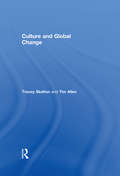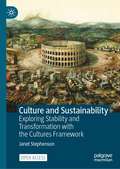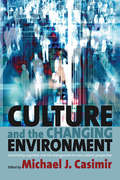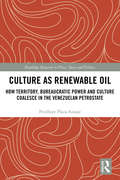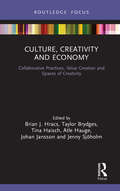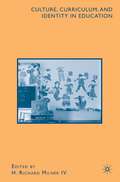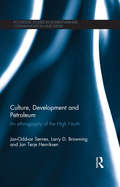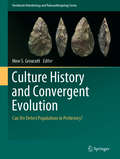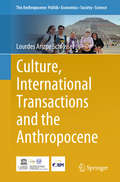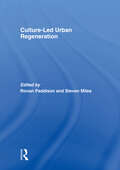- Table View
- List View
Culture and Global Change
by Tracey Skelton Tim AllenCulture and Global Change presents a comprehensive introduction to the cultural aspects of third world development. It contains 25 chapters from leading writers in the field who each explore a particular aspect of 'culture' and the significance and meaning of cultural issues for different people in throughout the contemporary world. With chapters dealing with the importance of 'Third World' cultures but also with changes in Russia, Japan, the USA and the UK, this book considers the relationship between culture and development within a truly global context.
Culture and Sustainability: Exploring Stability and Transformation with the Cultures Framework
by Janet StephensonThis Open access book brings a cultural lens, and a distinctive analytical framework, to the problem of transitioning to a sustainable, low-carbon future. The world faces a seemingly impossible hurdle – to radically alter long-established social, economic and technological systems in order to live within the biophysical limits of the globe, while ensuring a just and enduring transition. The overarching premise of this book is that this cannot be achieved without widespread cultural change. ‘We need a change in culture’ is often used rhetorically, but what does this really mean?Stephenson starts by exploring culture’s elusiveness, describing its divergent interpretations before identifying core features of culture that are common across most definitions. These characteristics form the core of the cultures framework, an extensively tested approach to studying the links between culture and sustainability outcomes. The framework makes culture an accessible concept which can be analytically applied to almost any sustainability problem. Using many examples from around the world, Stephenson illustrates how cultural stability, cultural flexibility and cultural transformation all have a part to play in the sustainability transition. She guides the reader in the use of the cultures framework for policy development and to underpin research undertaken by individuals or by multi-disciplinary teams.Clearly and engagingly written, Culture and Sustainability is essential reading for academics, students, policy makers and indeed anyone interested in a sustainable future.
Culture and Sustainability in European Cities: Imagining Europolis (Routledge Studies in Culture and Sustainable Development)
by Svetlana Hristova Nancy Duxbury Milena Dragićević ŠešićEuropean cities are contributing to the development of a more sustainable urban system that is capable of coping with economic crises, ecological challenges and social disparities in different nation-states and regions throughout Europe. This book reveals in a pluralistic way how European cities are generating new approaches to their sustainable development, and the special contribution of culture to these processes. It addresses both a deficit of attention to small and medium-sized cities in the framework of European sustainable development, and an underestimation of the role of culture, artistic expression and creativity for integrated development of the city as a prerequisite to urban sustainability. On the basis of a broad collection of case studies throughout Europe, representing a variety of regionally specific cultural models of sustainable development, the book investigates how participative culture, community arts, and more generally, creativity of civic imagination are conducive to the goal of a sustainable future of small and medium-sized cities. This is an essential volume for researchers and postgraduate students in urban studies, cultural studies, cultural geography and urban sociology as well as for policymakers and practitioners wanting to understand the specificity of European cities as hubs of innovation, creativity and artistic industriousness.
Culture and Sustainability in European Cities: Imagining Europolis (Routledge Studies in Culture and Sustainable Development)
by Svetlana Hristova Nancy Duxbury Milena Dragi EviEuropean cities are contributing to the development of a more sustainable urban system that is capable of coping with economic crises, ecological challenges and social disparities in different nation-states and regions throughout Europe. This book reveals in a pluralistic way how European cities are generating new approaches to their sustainable development, and the special contribution of culture to these processes. It addresses both a deficit of attention to small and medium-sized cities in the framework of European sustainable development, and an underestimation of the role of culture, artistic expression and creativity for integrated development of the city as a prerequisite to urban sustainability. On the basis of a broad collection of case studies throughout Europe, representing a variety of regionally specific cultural models of sustainable development, the book investigates how participative culture, community arts, and more generally, creativity of civic imagination are conducive to the goal of a sustainable future of small and medium-sized cities. This is an essential volume for researchers and postgraduate students in urban studies, cultural studies, cultural geography and urban sociology as well as for policymakers and practitioners wanting to understand the specificity of European cities as hubs of innovation, creativity and artistic industriousness.
Culture and the Changing Environment: Uncertainty, Cognition, and Risk Management in Cross-Cultural Perspective
by Michael J. CasimirToday human ecology has split into many different sub-disciplines such as historical ecology, political ecology or the New Ecological Anthropology. The latter in particular has criticised the predominance of the Western view on different ecosystems, arguing that culture-specific world views and human-environment interactions have been largely neglected. However, these different perspectives only tackle specific facets of a local and global hyper-complex reality. In bringing together a variety of views and theoretical approaches , these especially commissioned essays prove that an interdisciplinary collaboration and understanding of the extreme complexity of the human-environment interface(s) is possible.
Culture as Renewable Oil: How Territory, Bureaucratic Power and Culture Coalesce in the Venezuelan Petrostate (Routledge Research in Place, Space and Politics)
by Penélope Plaza AzuajeThis book unpacks the links between oil energy, state power, urban space and culture, by looking at the Petro-Socialist Venezuelan oil state. It challenges the disciplinary compartmentalisation of the analysis of the material and cultural effects of oil to demonstrate that within the Petrostate, Territory, Bureaucratic Power and Culture become indivisible. To this end, it examines how oil is a cultural resource, in addition to a natural resource, implying therefore that struggles over culture implicate oil, and struggles over oil implicate culture. This book develops a story about Venezuela as an oil state and the way it deploys its policies to instrumentalise culture and urban space by examining the way Petro-Socialism manifests in space, how it is imagined in speeches and how it is discursively constructed in adverts. The discussion reveals how a particular culture is privileged by the Venezuela state-owned oil company and its social and cultural branch. The book explores to what effect the state-owned oil company constructs a parallel notion of culture that becomes inextricable from land, akin to a mineral deposit, and tightly controlled by the Petrostate. The book will appeal to researchers who are interested in Resource Management, Environmental Studies, Cultural Studies and Political Geography.
Culture as Renewable Oil: How Territory, Bureaucratic Power and Culture Coalesce in the Venezuelan Petrostate (Routledge Research in Place, Space and Politics)
by Penélope Plaza AzuajeThis book unpacks the links between oil energy, state power, urban space and culture, by looking at the Petro-Socialist Venezuelan oil state. It challenges the disciplinary compartmentalisation of the analysis of the material and cultural effects of oil to demonstrate that within the Petrostate, Territory, Bureaucratic Power and Culture become indivisible. To this end, it examines how oil is a cultural resource, in addition to a natural resource, implying therefore that struggles over culture implicate oil, and struggles over oil implicate culture. This book develops a story about Venezuela as an oil state and the way it deploys its policies to instrumentalise culture and urban space by examining the way Petro-Socialism manifests in space, how it is imagined in speeches and how it is discursively constructed in adverts. The discussion reveals how a particular culture is privileged by the Venezuela state-owned oil company and its social and cultural branch. The book explores to what effect the state-owned oil company constructs a parallel notion of culture that becomes inextricable from land, akin to a mineral deposit, and tightly controlled by the Petrostate. The book will appeal to researchers who are interested in Resource Management, Environmental Studies, Cultural Studies and Political Geography.
Culture, Creativity and Economy: Collaborative Practices, Value Creation and Spaces of Creativity (The Dynamics of Economic Space)
by Brian J. Hracs Taylor Brydges Tina Haisch Atle Hauge Johan Jansson Jenny SjoholmThis book nuances our understanding of the contemporary creative economy by engaging with a set of three key tensions which emerged over the course of eight European Colloquiums on Culture, Creativity and Economy (CCE): 1) the tension between individual and collaborative creative practices, 2) the tension between tradition and innovation, and 3) the tension between isolated and interconnected spaces of creativity. Rather than focusing on specific processes, such as production, industries or locations, the tensions acknowledge and engage with the messy and restless nature of the creative economy. Individual chapters offer insights into poorly understood practices, locations and contexts such as co-working spaces in Berlin and rural Spain, creative businesses in Leicester and the role and importance of cultural intermediaries in creative economies within Africa. Others examine the nature of trans-local cultural flows, the evolving "field" of fashion, and the implications of social media and crowdfunding platforms. This book will be of interest to students, scholars and professionals researching the creative economy, as well as specific cultural and creative industries, across the humanities and social sciences.
Culture, Creativity and Economy: Collaborative Practices, Value Creation and Spaces of Creativity (The Dynamics of Economic Space)
by Brian J. Hracs Taylor Brydges Tina Haisch Atle Hauge Johan Jansson Jenny SjoholmThis book nuances our understanding of the contemporary creative economy by engaging with a set of three key tensions which emerged over the course of eight European Colloquiums on Culture, Creativity and Economy (CCE): 1) the tension between individual and collaborative creative practices, 2) the tension between tradition and innovation, and 3) the tension between isolated and interconnected spaces of creativity. Rather than focusing on specific processes, such as production, industries or locations, the tensions acknowledge and engage with the messy and restless nature of the creative economy. Individual chapters offer insights into poorly understood practices, locations and contexts such as co-working spaces in Berlin and rural Spain, creative businesses in Leicester and the role and importance of cultural intermediaries in creative economies within Africa. Others examine the nature of trans-local cultural flows, the evolving "field" of fashion, and the implications of social media and crowdfunding platforms. This book will be of interest to students, scholars and professionals researching the creative economy, as well as specific cultural and creative industries, across the humanities and social sciences.
Culture, Curriculum, and Identity in Education
by H. MilnerThis book analyzes equity and diversity in schools and teacher education. Within this broad and necessary context, the book raises some critical issues not previously explored in many multicultural and urban education texts.
Culture, Development and Petroleum: An Ethnography of the High North (Routledge Studies in Environmental Communication and Media)
by Jan-Oddvar Sornes Larry Browning Jan Terje HenriksenThe discovery, just forty years ago, of vast oil and gas reserves in the Southwestern part of Norway, and more recently in the Arctic High North region, created an economic titan and posed a vast array of challenges for both the Norwegian government and the residents of this area. How to extract and transport all that oil and gas without despoiling the pristine environment? How to use this wealth in a socially responsible and sustainable way? How to prepare the rural High North citizens—traditionally fishermen and farmers—for a global, high-tech economy? Adopting an original narrative approach to qualitative research, this book tells the stories of 21 individuals either living or having a genuine interest in the High North, from mayors and entrepreneurs to farmers and fishermen. Through these first-hand meetings, it constructs an ethnographic study that reveals how petroleum and development have impacted on the regional economy and culture. This book will be of interest to all stakeholders in the oil and gas industry, and for students and scholars of organization studies, cultural and communication studies, environmental anthropology, natural resource management and sustainable development.
Culture, Development and Petroleum: An Ethnography of the High North (Routledge Studies in Environmental Communication and Media)
by Jan-Oddvar Sornes Larry Browning Jan Terje HenriksenThe discovery, just forty years ago, of vast oil and gas reserves in the Southwestern part of Norway, and more recently in the Arctic High North region, created an economic titan and posed a vast array of challenges for both the Norwegian government and the residents of this area. How to extract and transport all that oil and gas without despoiling the pristine environment? How to use this wealth in a socially responsible and sustainable way? How to prepare the rural High North citizens—traditionally fishermen and farmers—for a global, high-tech economy? Adopting an original narrative approach to qualitative research, this book tells the stories of 21 individuals either living or having a genuine interest in the High North, from mayors and entrepreneurs to farmers and fishermen. Through these first-hand meetings, it constructs an ethnographic study that reveals how petroleum and development have impacted on the regional economy and culture. This book will be of interest to all stakeholders in the oil and gas industry, and for students and scholars of organization studies, cultural and communication studies, environmental anthropology, natural resource management and sustainable development.
Culture, Heritage and Representation: Perspectives on Visuality and the Past (Heritage, Culture and Identity)
by Steve WatsonThe 'visual' has long played a crucial role in forming experiences, associations, expectations and understandings of heritage. Images convey meaning within a range of practices, including tourism, identity construction, the popularization of the past through a variety of media, and the memorialization of events. However, despite the central role of 'the visual' in these contexts, it has been largely neglected in heritage literature. This edited collection is the first to explore the production, use and consumption of visual imagery as an integral part of heritage. Drawing on case studies from around the world, it provides a multidisciplinary analysis of heritage representations, combining complex understandings of the 'visual' from a wide range of disciplines, including heritage studies, sociology and cultural studies perspectives. In doing so, the book provides a comprehensive overview of the theoretical and methodological tools necessary for understanding visual imagery within its cultural context.
Culture, Heritage and Representation: Perspectives on Visuality and the Past (Heritage, Culture and Identity)
by Steve WatsonThe 'visual' has long played a crucial role in forming experiences, associations, expectations and understandings of heritage. Images convey meaning within a range of practices, including tourism, identity construction, the popularization of the past through a variety of media, and the memorialization of events. However, despite the central role of 'the visual' in these contexts, it has been largely neglected in heritage literature. This edited collection is the first to explore the production, use and consumption of visual imagery as an integral part of heritage. Drawing on case studies from around the world, it provides a multidisciplinary analysis of heritage representations, combining complex understandings of the 'visual' from a wide range of disciplines, including heritage studies, sociology and cultural studies perspectives. In doing so, the book provides a comprehensive overview of the theoretical and methodological tools necessary for understanding visual imagery within its cultural context.
Culture History and Convergent Evolution: Can We Detect Populations in Prehistory? (Vertebrate Paleobiology and Paleoanthropology)
by Huw S. GroucuttThis volume brings together diverse contributions from leading archaeologists and paleoanthropologists, covering various spatial and temporal periods to distinguish convergent evolution from cultural transmission in order to see if we can discover ancient human populations. With a focus on lithic technology, the book analyzes ancient materials and cultures to systematically explore the theoretical and physical aspects of culture, convergence, and populations in human evolution and prehistory. The book will be of interest to academics, students and researchers in archaeology, paleoanthropology, genetics, and paleontology. The book begins by addressing early prehistory, discussing the convergent evolution of behaviors and the diverse ecological conditions driving the success of different evolutionary paths. Chapters discuss these topics and technology in the context of the Lower Paleolithic/Earlier Stone age and Middle Paleolithic/Middle Stone Age. The book then moves towards a focus on the prehistory of our species over the last 40,000 years. Topics covered include the human evolutionary and dispersal consequences of the Middle-Upper Paleolithic Transition in Western Eurasia. Readers will also learn about the cultural convergences, and divergences, that occurred during the Terminal Pleistocene and Holocene, such as the budding of human societies in the Americas. The book concludes by integrating these various perspectives and theories, and explores different methods of analysis to link technological developments and cultural convergence.
Culture, International Transactions and the Anthropocene: Culture And Heritage In A Cosmopolitan World (The Anthropocene: Politik—Economics—Society—Science #17)
by Lourdes Arizpe SchlosserThis book analyses how global transactions have been progressively conducted and negotiated in the last 25 years. Achieving a new understanding of sustainability transition in the Anthropocene requires a deeper analysis on culture. The development of new positions of international institutions, national governments, scientific organizations, private fora and civil society movements on culture and nature shows how global transactions must take place in a rapidly transforming world. In her book the author provides a multi-situated ethnography of live debates on culture, global environmental change, development and diversity directly recorded by the author as a participating and decision-making anthropologist from 1988 to 2016. She examines the politicization and internationalization of culture by recognizing, negotiating and diversifying views on cultures and re-thinking culture in the Anthropocene. The merging of science and policy in taking up cultural and natural challenges in the Anthropocene is discussed.
Culture-Led Urban Regeneration (Urban Studies Monographs)
by Ronan PaddisonThe idea that culture can be employed as a driver for urban economic growth has become part of the new orthodoxy by which cities seek to enhance their competitive position. Such developments reflect not only the rise to prominence of the cultural sphere in the contemporary (urban) economy, but how the meaning of culture has been redefined to include new uses in order to meet social, economic and political objectives. This significant book focuses on the ability of cultural investment to meet the rhetoric of social inclusion and the extent to which it offers sustainable solutions to the problems of the city. To this end it focuses on the meanings and practice of culture-led policy within the city and its evaluation is proposed. Paddison and Miles have edited an innovative book which presents a series of diverse case studies to challenge the ‘one size fits all’ model of culture-led urban regeneration - a key concern being the extent to which culture-led regeneration can genuinely fulfil the expectations that policy-makers and urban commentators have of it.This book was previously published as a special issue of Urban Studies.
Culture-Led Urban Regeneration (Urban Studies Monographs)
by Ronan Paddison R. Steven MilesThe idea that culture can be employed as a driver for urban economic growth has become part of the new orthodoxy by which cities seek to enhance their competitive position. Such developments reflect not only the rise to prominence of the cultural sphere in the contemporary (urban) economy, but how the meaning of culture has been redefined to include new uses in order to meet social, economic and political objectives. This significant book focuses on the ability of cultural investment to meet the rhetoric of social inclusion and the extent to which it offers sustainable solutions to the problems of the city. To this end it focuses on the meanings and practice of culture-led policy within the city and its evaluation is proposed. Paddison and Miles have edited an innovative book which presents a series of diverse case studies to challenge the ‘one size fits all’ model of culture-led urban regeneration - a key concern being the extent to which culture-led regeneration can genuinely fulfil the expectations that policy-makers and urban commentators have of it.This book was previously published as a special issue of Urban Studies.
The Culture of Nature in the History of Design
by Kjetil FallanThe Culture of Nature in the History of Design confronts the dilemma caused by design’s pertinent yet precarious position in environmental discourse through interdisciplinary conversations about the design of nature and the nature of design. Demonstrating that the deep entanglements of design and nature have a deeper and broader history than contemporary discourse on sustainable design and ecological design might imply, this book presents case studies ranging from the eighteenth to the twenty-first century and from Singapore to Mexico. It gathers scholarship on a broad range of fields/practices, from urban planning, landscape architecture, and architecture, to engineering design, industrial design, furniture design and graphic design. From adobe architecture to the atomic bomb, from the bonsai tree to Biosphere 2, from pesticides to photovoltaics, from rust to recycling – the culture of nature permeates the history of design. As an activity and a profession always operating in the borderlands between human and non-human environments, design has always been part of the environmental problem, whilst also being an indispensable part of the solution. The book ventures into domains as diverse as design theory, research, pedagogy, politics, activism, organizations, exhibitions, and fiction and trade literature to explore how design is constantly making and unmaking the environment and, conversely, how the environment is both making and unmaking design. This book will be of great interest to a range of scholarly fields, from design education and design history to environmental policy and environmental history.
The Culture of Nature in the History of Design
by Kjetil FallanThe Culture of Nature in the History of Design confronts the dilemma caused by design’s pertinent yet precarious position in environmental discourse through interdisciplinary conversations about the design of nature and the nature of design. Demonstrating that the deep entanglements of design and nature have a deeper and broader history than contemporary discourse on sustainable design and ecological design might imply, this book presents case studies ranging from the eighteenth to the twenty-first century and from Singapore to Mexico. It gathers scholarship on a broad range of fields/practices, from urban planning, landscape architecture, and architecture, to engineering design, industrial design, furniture design and graphic design. From adobe architecture to the atomic bomb, from the bonsai tree to Biosphere 2, from pesticides to photovoltaics, from rust to recycling – the culture of nature permeates the history of design. As an activity and a profession always operating in the borderlands between human and non-human environments, design has always been part of the environmental problem, whilst also being an indispensable part of the solution. The book ventures into domains as diverse as design theory, research, pedagogy, politics, activism, organizations, exhibitions, and fiction and trade literature to explore how design is constantly making and unmaking the environment and, conversely, how the environment is both making and unmaking design. This book will be of great interest to a range of scholarly fields, from design education and design history to environmental policy and environmental history.
The Culture of Ships and Maritime Narratives (British School at Athens - Modern Greek and Byzantine Studies #7)
by Chryssanthi PapadopoulouThe ship transcends the descriptive categories of place, vehicle and artefact; it is a cosmos, which requires its own cosmology. This is the subject matter of this volume, which falls within the broader, flourishing sub-field of maritime anthropology. Specifically, the volume first investigates the dialectic between the sea, the ship and the ship-dweller and shows how traits are exchanged between the three. It then focuses on land-dwellers, their understanding of seaborne existence and their invaluable contribution to the culture of ships. It shows that the romanticised views of life at sea that land-dwellers hold constitute an important aspect of the cosmology of ships and they too need to be considered if the polyvalence of ships is to be fully understood. In order for this cosmology to be written, some of the volume’s contributors have travelled on ships and interviewed mariners, fishermen, boat-builders and boat-dwellers; others have traced the courses of ships in poems, films, philosophical texts, and collective myths of genealogy and heritage. Overall the volume shows where ships can go, and how they are perceived and experienced by those living and travelling in them, watching and waiting for them, dreaming and writing about them, and, finally, what literal and metaphorical crews man them.
The Culture of Ships and Maritime Narratives (British School at Athens - Modern Greek and Byzantine Studies #7)
by Chryssanthi PapadopoulouThe ship transcends the descriptive categories of place, vehicle and artefact; it is a cosmos, which requires its own cosmology. This is the subject matter of this volume, which falls within the broader, flourishing sub-field of maritime anthropology. Specifically, the volume first investigates the dialectic between the sea, the ship and the ship-dweller and shows how traits are exchanged between the three. It then focuses on land-dwellers, their understanding of seaborne existence and their invaluable contribution to the culture of ships. It shows that the romanticised views of life at sea that land-dwellers hold constitute an important aspect of the cosmology of ships and they too need to be considered if the polyvalence of ships is to be fully understood. In order for this cosmology to be written, some of the volume’s contributors have travelled on ships and interviewed mariners, fishermen, boat-builders and boat-dwellers; others have traced the courses of ships in poems, films, philosophical texts, and collective myths of genealogy and heritage. Overall the volume shows where ships can go, and how they are perceived and experienced by those living and travelling in them, watching and waiting for them, dreaming and writing about them, and, finally, what literal and metaphorical crews man them.
The Culture of the Gift in Eighteenth-Century England
by C. KlekarThe Culture of the Gift in Eighteenth-Century England analyzes the long overlooked role of gift exchange in literary texts and cultural documents and provides innovative readings of how gift transactions shaped the institutions and practices that gave this era its distinctive identity.
Culture, Participation and Policy in the Municipal Public Park (Palgrave Studies in Cultural Participation)
by Abigail GilmoreThis book concerns the values and practices of participation in municipal public parks, and the connections they have with cultural policy, urbanism, and social life. Adopting a critical cultural policy lens, it identifies the park as a mundane but extraordinarily treasured place for the production and exchange of cultural values, regulation, resistance, and the practising of citizenship. Drawing on extensive mixed-methods research on everyday participation in diverse local cultural ecosystems in England and Scotland, the book examines the social lives of parks and their users, and the important public values that are generated through their common stewardship and usership. It presents case studies of parks and co-located museums as cultural public spheres, which promote both commoning and commodification. These are contextualized by histories of municipal parkmaking from the nineteenth century to the present and related to the making of local government and to other civic and cultural institutions.The book highlights contemporary issues of austerity, marketisation and de-municipalisation within local government in the context of urban development. It positions the public park as fundamental to democratic cultural governance and makes the case for the primacy of public trust, ownership, and park equity in safeguarding the right to the city.
Culture/Place/Health (Critical Geographies #Vol. 16)
by Wilbert M. Gesler Robin A. KearnsCulture/Place/Health is the first exploration of cultural-geographical health research for a decade, drawing on contemporary research undertaken by geographers and other social scientists to explore the links between culture, place and health. It uses a wealth of examples from societies around the world to assert the place of culture in shaping relations between health and place. It contributes to an expanding of horizons at the intersection of the discipline of geography and the multidisciplinary domain of health concerns.
